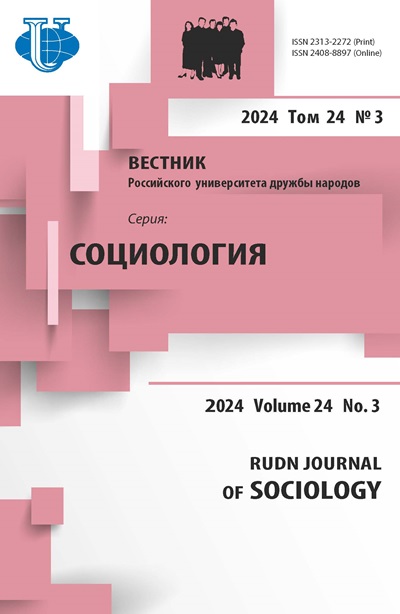Civil and ethnic identities as markers of inter-ethnic relations in the Russian border regions
- Authors: Maximova SG1, Morkovkina AG2
-
Affiliations:
- Altai State University
- Lomonosov Moscow State University
- Issue: Vol 16, No 2 (2016)
- Pages: 347-358
- Section: Surveys, experiments, case studies
- URL: https://journals.rudn.ru/sociology/article/view/6475
Cite item
Full Text
Abstract
The article presents the results of the study of civil and ethnic identities and the sphere of interethnic relations in eight Russian regions located near the state borders: the Altai region, Amur region, Jewish Autonomous region, Trans-Baikal region, Kemerovo region, Omsk region, Orenburg region, and the Altai Republic. The authors conducted a survey to gather empirical data and identify the priority of civic identity for the residents of border regions of Russia, and the dominant grounds of civil and ethnic identities. The results of the survey show significant regional differences in the level of different identities manifestation: the highest degree of identification with the civil and ethnic communities is typical for the Kemerovo region, the lowest - for the Trans-Baikal region. The authors assess the characteristics of inter-ethnic relations, and make conclusions about their dynamics and the level of inter-ethnic tension in each region: the most problematic regions in this respect are the Trans-Baikal region and Omsk region. The study identified a number of facts, which require further scientific interpretation, for example, in some regions there are statistically significant proportions of the population with a very low level of national-state identification.
About the authors
S G Maximova
Altai State University
Author for correspondence.
Email: svet-maximova@yandex.ru
Psychology of Communications and Psycho-Technologies Chair
A G Morkovkina
Lomonosov Moscow State University
Email: soccomsys@mail.ru
Sociology of Communication Systems Chair
References
- Gorshkov M.K. Rossiyskaya identichnost v usloviyah transformiruyuschihsya protsessov [Rus-sian identity under the transformation processes] // Vestnik rossiyskoy natsii. 2008. № 1.
- Grozdya gneva. Reyting mezhetnicheskoy napryazhennosti v regionah Rossii [The grapes of wrath. Rating of inter-ethnic tensions in the regions of Russia] // TsINK. 2014 // URL: http://club-rf.ru/thegrapesofwrath/01/index.html.
- Drobizheva L.M. Teoreticheskie problemyi izucheniya grazhdanskoy identichnosti i sotsialnaya praktika [Theoretical problems of studying civil identity and social practice] // Setevoe izdanie Tsentra issledovaniy i analitiki Fonda istoricheskoy perspektivyi «PERSPEKTIVY», 2014 // URL: http://www.perspektivy.info/rus/gos/ teoreticheski-je_problemy_izuchenija_grazhdanskoj_identichnosti_i_socialnaja_praktika_2014-09-10.htm.
- Zimina N.S., Kolpakova T.V. Vnutrenniy imidzh Baykalskogo regiona v kontekste ego sotsiokulturnogo razvitiya (na primere Zabaykalskogo kraya) [Internal image of the Baikal re-gion in the context of its social and cultural development (on the example of Trans-Baikal re-gion)] // Sovremennyie problemy nauki i obrazovaniya. 2014. № 6.
- Shikova R.Yu. Grazhdanskaya identichnost sovremennoy molodezhi: sotsiokulturnyiy analiz (na primere respubliki Adygea) [Civil Identity of Today’s Youth: Socio-Cultural Analysis (on the example of the Republic of Adygea)] // Avtoref diss. … k.s.n. Maykop, 2010.
- Shirokogorov S.M. Etnos. Issledovanie osnovnyih printsipov izmeneniya etnicheskih i etnograficheskih yavleniy [Ethnos. A Study of the Changes in the Basic Principles of Ethnic and Ethnographic Phenomena]. M., 2010.
- Berry J.W. Acculturation and psychological adaptation review // Journeys into Cross-Cultural Psychology: Selected papers from the 11th International con-ference of the International association for cross-cultural psychology held in Liege, Belgium / Ed. by A.M. Bouvy. Liege, 2006.
- Iyer A., Jetten J., Tsivrikos D., Postmes T., Haslam S.A. The more (and the more compatible) the merrier: Multiple group memberships and identity com-patibility as predictors of adjustment after life transitions // British Journal of Social Psychology. 2009. № 48.
- Nasie M., Bar-Tal D., Pliskin R., Nahhas E., Halperin E. Overcoming the bar-rier of narrative adherence in conflicts through awareness of the psychological bias of naive realism // Personality and Social Psychology Bulletin. 2014. № 40.
- Smith T.W. National pride in comparative perspective // The International So-cial Survey Programme 1984-2009: Charting the Globe. London: Routledge, 2009.
- Swann W.B. Jr., Gamez A., Seyle C.D., Morales F.J., Huici C. Identity fusion: The interplay of personal and social identities in extreme group behavior // Journal of Personality and Social Psychology. 2009. № 96.
- Tajfel H., Turner J.С. The social identity theory of intergroup behavior // Psy-chology of Intergroup Relations / Ed. by S. Worchel, W.G. Austin. Chicago: Nelson-Hall, 1986.














